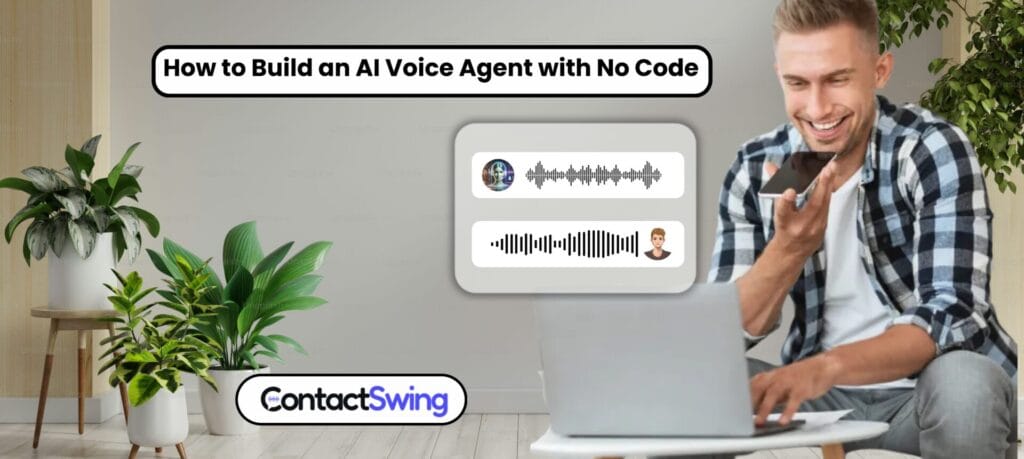
Introduction
Conversational AI voice agents are the newest way of introducing efficiency you’ve never heard of. However, using agents that can talk like humans, handle customer service, integrate with CRMs, and understand and respond emotionally- Sounds like a coder’s nightmare.
Building an AI voice agent used to be extremely tough- but not anymore.
Today, the landscape has changed dramatically. Thanks to the rise of no-code AI platforms for conversational voice bots, creating intelligent, responsive voice agents is no longer restricted to the realm of developers. Now, business owners, marketers, and customer service managers alike can build AI voice bots without coding—saving time, money, and perhaps a few grey hairs along the way.
In this article, we’ll unpack exactly how to create an AI voice agent without coding. We’ll explore why voice agents are a game-changer for businesses, what you need to know before starting, the steps to build a voice AI agent with no programming, and the best no-code AI tools for voice assistants. We’ll also dive into real-world examples and common challenges and offer solutions that will leave you feeling confident about making your AI voice dreams a reality.
Get ready to discover how easy it is to create a AI voice agent without coding, and why it might just be the smartest business move you make this year.
Why Build an AI Voice Agent?
Today’s customers expect businesses to be always on, ready to assist at any hour. Sleep, it seems, is no longer a business strategy. Enter the no-code AI voice agent: your tireless, ever-attentive brand ambassador.
The benefits are compelling:
1. Cost savings: One AI voice agent can handle the workload of multiple customer service reps—without overtime pay.
2. Scalability: AI agents can simultaneously manage hundreds of conversations, meaning no caller is left waiting on hold.
3. Consistency: Each customer receives the same friendly, accurate service, whether it’s midnight or Monday morning.
Use cases span industries:
a. Healthcare providers scheduling appointments
b. Retailers offering order updates
c. Financial services qualifying leads
d. Hospitality businesses handling reservations
Recent studies show that 48% of customers prefer to call for customer service instead of typing, due to familiarity and expressiveness. Voice brings a level of personalization and warmth that text or chatbots can’t always provide, leading to more personal interactions and emotions.
What You Need to Know Before Starting
Before you jump into the no-code deep end, let’s cover a few essentials.
AI voice agents cannot be used just as is- they require a lot of training and familiaritywith your business to function- so you need to be prepared with your business’ data and our specific use case.
Next, familiarize yourself with some key terminology:
1. NLP (Natural Language Processing): The technology that helps AI understand human speech.
2. Intents: The purpose behind a customer’s query (e.g., booking an appointment).
3. Utterances: Different ways a customer might express the same intent.
4. Entities: Specific information extracted from conversation (like dates, and locations).
Setting realistic expectations is crucial. While today’s voice AI is remarkably sophisticated, it’s not perfect. Complex, multi-layered conversations may still require a human handoff.
Prepare your content in advance: FAQs, scripts for common scenarios, fallback responses for when the AI is unsure, knowledge base (specific to your business) and escalation plans for transferring to live agents.
With your foundation in place, you’re ready to roll up your sleeves—and build.
5 Steps to Build a Voice AI Agent Without Coding
Step 1: Define Your Voice Agent’s Purpose and Scope
Before building, blueprint your bot:
a. Identify specific tasks: Will your agent book appointments? Answer FAQs? Process orders?
b. List common scenarios: Create a database of likely customer questions.
c. Set success metrics: Examples include call resolution rates, customer satisfaction scores, and average handling time.
d. Create user personas: Understand your typical caller’s demographics, needs, and frustrations.
e. Plan human handoffs: Establish clear escalation paths for complex or sensitive issues.
Without a clear purpose, even the best-designed agent can quickly go off-script—literally and figuratively.
Step 2: Choose the Right No-Code Platform
The right AI voice can fulfil your exact needs- but you need to choose the right one.
Look for:
a. Natural Language Understanding (NLU) capabilities
b. Seamless integration with your CRM, calendar, or ticketing systems
c. Scalability to handle growing customer volumes
d. User-friendly interface requiring minimal training
e. Industry-specific templates and specialization to jumpstart development
Popular platforms include ContactSwing, known for its intuitive interface and business-ready solutions, alongside other competitors discussed below.
Consider pricing models carefully. Some platforms offer pay-as-you-go, and others charge based on minutes—choose what fits your forecasted needs.
Step 3: Design Your Conversation Flows
Design your AI to talk like a person, not like a… well, bot.
a. Create natural dialogue patterns: Use contractions, polite phrases, and a conversational tone.
b. Map conversation paths: Visualize different customer journeys and create branching responses.
c. Handle unexpected inquiries: Always have a “sorry, I didn’t catch that” or “let me transfer you” fallback.
d. Test rigorously: Dry-run multiple conversation paths to catch snags before launch.
Remember: even the best AI needs a well-scripted plan to sound authentically human.
Step 4: Train Your AI Voice Agent
Training is where the magic happens:
a. Provide varied utterances: Teach your AI the many ways humans can say “I want to book a table.”
b. Add entity recognition: Help it catch names, dates, amounts, and other specifics.
c. Develop a knowledge base: Equip your agent with a library of FAQs and canned responses.
d. Test and refine: Simulate hundreds of conversations to sharpen the agent’s understanding and adaptability.
Like any good trainee, practice makes perfect.
Step 5: Launch, Monitor, and Improve
Ready, set, go—but first, test!
a. Deploy in a test environment to iron out last-minute wrinkles.
b. Gather feedback from early users.
c. Launch officially with clear communication to your audience.
d. Monitor metrics: Track call completion rates, average resolution time, and customer satisfaction.
e. Commit to continuous improvement: Update scripts and retrain regularly.
Voice AI is a marathon, not a sprint. Staying nimble ensures long-term success.
Top 5 No-Code AI Voice Agent Platforms
1. ContactSwing
When it comes to no-fuss, high-impact AI voice agents, ContactSwing hits all the right notes.
Key features include:
1. Advanced Natural Language Understanding (NLU)
2. Seamless human handoff when needed
3. Powerful analytics dashboard for tracking performance
4. Industry-specific specialization to speed up deployment
5. Integrations with popular CRMs and ticketing systems
6. Affordable pricing tiers for businesses of all sizes
Designed with business users in mind, ContactSwing’s platform ensures you don’t need to “speak geek” to get going.
2. VoiceFlow
1. Drag-and-drop interface for building complex flows
2. Excellent for prototyping voice applications
3. Supports Alexa and Google Assistant integrations
4. More developer-oriented for deeper customizations
5. Pricing scales based on team size and features
3. Twilio Autopilot
1. Highly customizable conversational AI builder
2. Rich API integrations for deeper enterprise use
3. Steeper learning curve compared to others
4. Best for businesses already using Twilio’s suite
4. Cognigy.AI
1. Enterprise-grade conversational AI platform
2. Multichannel capabilities (voice, chat, SMS)
3. Extensive NLP capabilities and analytics
4. Premium pricing for larger businesses
5. Botpress
1. Exceptionally lifelike voice synthesis with emotional inflection
2. Easy no-code setup designed for business users
3. Strong context retention across extended conversations
4. Customizable conversation templates for faster deployment
Common Challenges and Solutions
Even the smoothest AI voice agent will encounter bumps:
1. Unexpected questions: Build a robust fallback strategy.
2. Accent variation: Train with diverse voice samples.
3. Natural-sounding conversations: Regularly refresh scripts and phrasing.
4. Proper handoff: Ensure escalation paths are well-mapped.
5. Balancing automation with personalization: Insert friendly touches, like using the caller’s name.
6. Performance measurement: Set clear KPIs and schedule regular reviews.
Anticipating hurdles before they arise keeps your AI agent running like a well-oiled machine.
Real-World Applications of No-Code Voice AI Agents
Practical applications abound:
1. Customer Service: Answer FAQs, reset passwords, track orders.
2. Appointment Scheduling: Book meetings, send reminders, confirm changes.
3. Sales: Collect information and route hot leads to sales reps.
4. Retail: Check inventory, update shipping status, handle returns.
5. FAQ Management: Offer self-service information without wait times.
6. Notifications and Alerts: Deliver proactive outreach for service updates or promotions.
The possibilities are nearly endless—and continually growing.
Why ContactSwing Stands Out for No-Code Voice AI
ContactSwing is purpose-built for non-technical business users who need powerful results without a steep learning curve.
Here’s why it shines:
1. Pre-built industry expertise to get you to launch faster.
2. Natural language capabilities make conversations feel truly human.
3. Analytics dashboards offer real-time insights for optimization.
4. Flexible pricing fits businesses from startups to enterprises.
5. Dedicated support helps guide you through every step of your voice AI journey.
In short: ContactSwing lets you “speak business” fluently—without ever needing to code. Interested in testing it out yourself? Get 50 free AI call minutes and experience it yourself.
Conclusion and Next Steps
Building a no-code conversational AI voice agent is no longer reserved for tech wizards. Today’s tools allow anyone to design, deploy, and delight customers through intelligent voice interactions.
Start small: pick one use case, build confidence, and scale thoughtfully. Continuous learning and iteration are the keys to success.
Ready to experience the future of voice? Visit contactswing and take the first step toward smarter, more personal customer engagement.
FAQs
How long does it typically take to build a voice AI agent with no code?
Usually 1–3 weeks, depending on the complexity of use cases and the amount of testing needed.
Do I need any technical knowledge to use these platforms?
Minimal to none. Most no-code platforms are designed for business users with no programming experience.
Can I integrate my voice agent with my existing business systems?
Yes, many no-code voice AI platforms like ContactSwing offer out-of-the-box integrations with CRMs, ticketing systems, and more.
How do these voice agents handle different accents or speech patterns?
Training with diverse sample utterances and leveraging advanced NLP engines helps agents recognize a wide range of accents and variations.
What happens if the voice agent can’t answer a question?
A well-designed agent will escalate the issue to a human representative or provide fallback responses to maintain the customer experience.
How much customization is possible without coding?
A lot! You can design conversation flows, customize responses, integrate knowledge bases, and manage escalation paths—all through intuitive interfaces.




